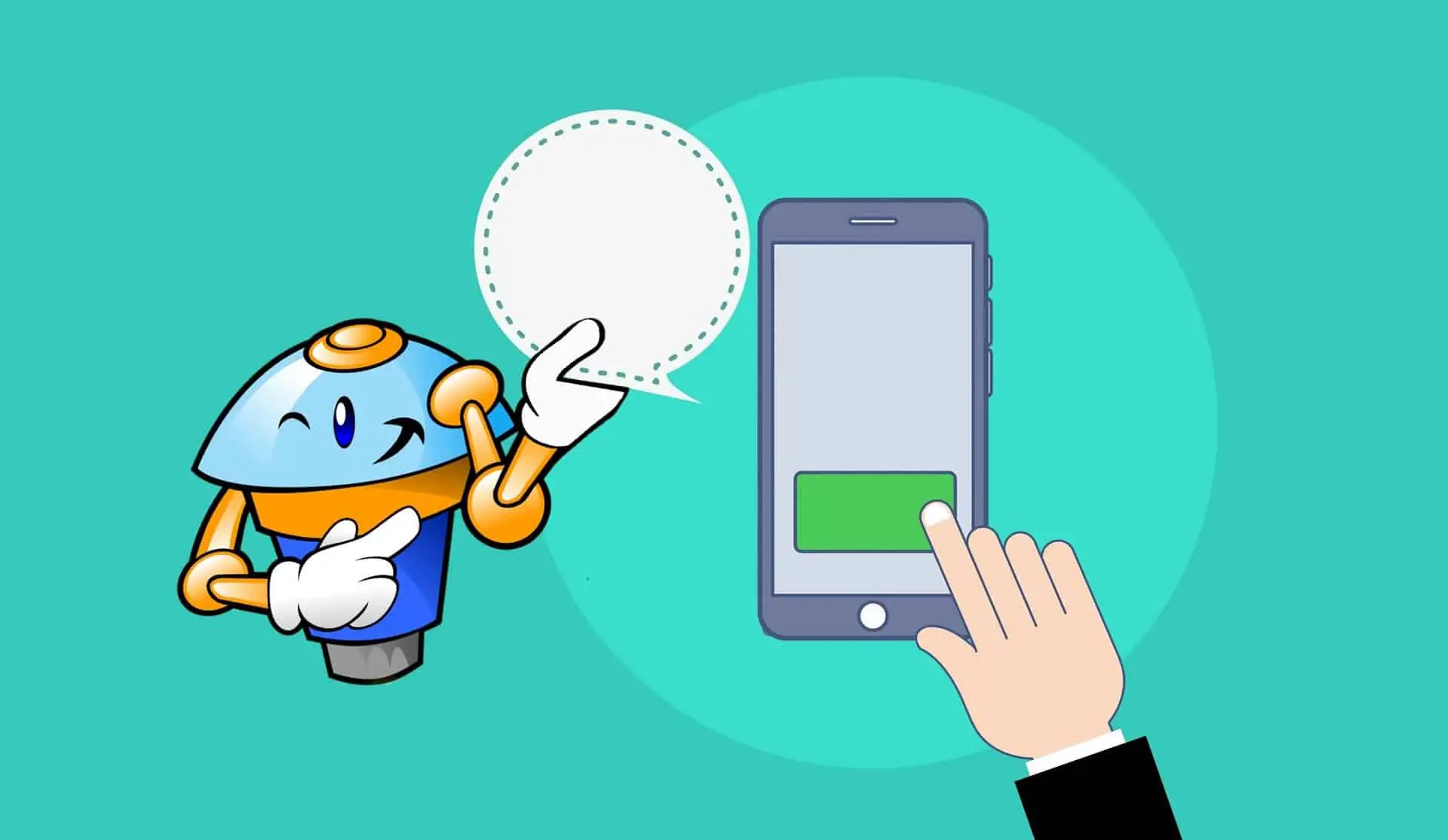Ever since the development of the internet, almost every aspect of business, commerce, and even human socialization have experienced a paradigm shift due to numerous technological advancements produced almost every other day.
One of these advancements is in computers and how we can communicate with them. The simplest and most effective way to communicate with a computer is through typing. However, over the last couple of years, there has been a steady rise in a nascent yet revolutionary communication method with machines: chatbots.
Chatbots work by receiving input, interpreting it, and then responding according to a predetermined set of rules. The input normally takes the form of a question, and the internal logic of the chatbots allows it to determine the best response to the question. The response is then delivered.
Chatbots are without a doubt the most promising and most exciting tool when it comes to Artificial intelligence and how we can use it to make daily tasks a lot easier. Using bots and chatbots, businesses and companies can automate how they respond to customer inquiries, such as the customers’ questions repeatedly.
This reduces the pressure of replaying on the part of the company or organization and offers faster, almost instantaneous replays to the consumer.
Notwithstanding, though bots and chatbots have proven that they can be hugely advantageous to both the business and the client, they are nascent, and there is still a lot of research being conducted to enhance improvements. This article will help you get the gist of everything that is known about chatbots.

What are chatbots?
In the most general of terms, a bot is computer software that can automate tasks. Chatbots are bots, essentially, since they are designed to make it possible for machines and computers to communicate.
The natural definition of a chatbot is a program or software developed for the specific purpose of making it possible for a human and a machine to have a discussion, interaction, and conversation. An example of this is when a user asks the program a question, and the chatbot either responds with an answer or performs a task or activity in response.
Chatbots are in many ways akin to instant messaging. However, instead of having a human on the other end, Artificial Intelligence formulates the answers to the queries posed. Machine learning, which is an integral part of Artificial Intelligence, makes it possible for the machine, over time, to formulate more elaborate and eloquent answers. More on that later.
Chatbots are designed in such a way that they can function independently from a human operator. It can understand what is asked and answers in the same way a human would. Its answers are based on a combination of machine learning applications and predefined scripts.
If a concept that the chatbot is not familiar with during the conversation is brought up, it will either deflect the conversation or pass the communication to a human operator. Either way, the concept will only be new for a little while, as the machine will learn about it and answer questions about it next time around.
Chatbots have become prevalent in the market, as every business tries to one-up its competitors. Some of the more famous chatbots include Siri, present in all Apple products, Microsoft’s Cortana, and Amazon’s Alexa.

Historical outline
As mentioned earlier, chatbots are powered by Artificial Intelligence. Artificial Intelligence is a very broad term. It is comprised of, amongst other things. Machin translation, predictive parsing, and computer vision. Two of its integral pillars, however, are Natural Language Understanding and Natural Language Generation.
Natural Language Processing, abbreviated as NLP, is a field of data science focused on how computers can interact with human language. Its main challenge today is to provide a way to process large quantities of human language data effectively.
Natural Language Understanding, NLU, deals with how the computer or machine can break down the language data and understand even the nuances of the conversation. Thus, it contains aspects such as intent recognition.
The two entities even form the pillars for the chatbots. Creating a means through which computers can distinctively understand what humans are saying, and offer an intuitive and accurate response, is a challenge that is being solved even today.
The first chatbots were developed a while back, believe it or not. It began with Alan Turing in the 50s, then the Eliza program in the 60s, followed by the machine learning and linguistics research programs that run in the 1990s, where computer scientists began to create software that could analyze large amounts of data and produce conclusive results.
That being said, the turning point of this was in 2001, when Richard Wallace developed the Artificial Intelligence Markup Language, used it to create A.L.I.C.E, Artificial Linguistic Internet Computer Entity, perhaps the first-ever chatbot.
ALICE runs using the rule-based approach, the first and most fundamental method of creating chatbots. Over the next ten years, the software was rethought and re-engineered to improve its functionality and methodology.
By developing algorithms that define semantic similarities and machine learning, the area has changed quite drastically over the last couple of years.

Types of chatbots
Though they are the most complex programs and software, chatbots are fundamentally similar to the regular application in their design. They have the application layers, the databases, where the data collected is stored, Conversation User Interfaces, CUIs, that are where the actual interaction take place, and the APIs, the Application Programming Interface, that essentially allows two programs, or parts of a program, to communicate with one another.
With that basic yet fundamental understanding of the makeup of chatbots, it is simple to understand their categories.
There are three main categories of chatbots, and their functionality separates them. In essence, the way a chatbot can communicate with the user, draw a conclusion and communicate the results back determines what category the chatbot falls in.
Rule-based chatbots
This was the method used to develop the first chatbots, like ALICE, and because of its effectiveness, it is still used today. The way these chatbots operate is pretty simple and straightforward. They have predefined responses in their database, and certain specific questions trigger these responses.
For example, should a customer ask the chatbot ‘Do you have any white shoes?’, the chatbot will already answer the question, since it has the specific question in the database, and thus can offer a very specific answer ‘Yes, we do.’
The downside with these particular chatbots, and the reason they are slowly being phased out, is that the customers’ questions are not that straightforward more often than not. In the earlier example, if a customer were to ask, ‘Any shoes with a white sole and white laces?’, it will not respond appropriately or even respond at all.

Intelligent chatbots
Intelligent chatbots can use what is referred to as Machine Learning. Machine learning, essentially, is a set of algorithms that make it possible for the computer by accessing both the user’s past questions and whether it had been asked previously to incorporate new concepts and thus responses into its database.
For example, a machine is asked the same question as before ‘Do you have any white shoes?’ if it is unable to respond, it will pass the line of communication to a human operator. However, afterward, the machine or computer will incorporate the question and the response that the human operator gave into its database.
Thus, the more the chatbot interacts with the consumers, the more nascent concepts it can incorporate into its databases, and ergo the more effective and efficient it becomes. Thus, over time, they can understand more complex questions and offer far better responses.
Intelligent chatbots can recognize not entire sentences but specific phrases and words, which trigger the chatbot to reply. The phrase ‘white shoes’ could be the trigger in this instance.
AI-powered chatbots
AI-powered chatbots combine the rule-based method with intelligently independent programs to solve any problems or answer any questions. These chatbots can remember all conversations it has taken part in with a specific user. Thus, it can also understand the user’s preferences and the context of the conversation and interaction.
They do so by using a combination of features and programs, such as machine learning, natural language processing, and Artificial Intelligence in general. Natural Language processing is actually very helpful in this instance since it can make the conversation or interaction seem more natural and human-like.
How do chatbots work?
Essentially, there are three ways of classifying chatbots based on how they run.
- Pattern-matching
Here, the chatbot can recognize certain phrases and keywords in the question posed or problem brought forward, and uses these phrases and keywords to search, from within its system, a worthy reply.
In pattern matching, however, the chatbot can only respond to questions that it already has in its database or models and cannot go beyond the patterns that have been implemented into its system.
An example is if a customer asks the chatbot, ‘Are there any red dresses?’. The phrase ‘red dresses’ is a trigger for the machine to start looking for a solution. If the solution is affirmative, then it will answer as such. However, if the client asks this question and neither the full question nor the phase or keyword is in the chatbot’s database, the chatbot will not respond.
- Algorithm
Algorithms ostensibly create unique patterns and trends that make it possible for the chatbot’s program to derive a solution for a problem. The chatbot needs to have a unique pattern or trend to solve each question or problem.
If the question ‘Do you have any red dresses’ is posed to a chatbot that uses algorithms, it will look for a trend with the phrase ‘red dresses.’ There may be different trends, with some, say, based on the color of the dress.
The ‘red dresses’ trend or pattern will also answer whether there are any left or not, and all the chatbot program has to do is obtain this solution and communicate it to the customer.
- Artificial neural networks
This is the most complex method through which a chatbot can get a response. However, it also offers the most elaborate and human-like responses. Artificial neural networks make it possible for the program to calculate the response it will give by weighing different data connections and contexts.
With artificial neural networks, every sentence of the problem is broken down, and each of the words is used as an input point for the neutral network. Thus, it can decode the problem faster, with more accuracy, and understand the different nuances people may pose.
As more and more questions are posed into the artificial neural network chatbots, they become conversant with different topics, and the faster and more effective they become.
Industries that use chatbots
Here are a couple of industries that have begun to incorporate the use of chatbots, that are tailor suited for chatbots.
- Call centers
Call centers are best suited for chatbots. In fact, certain companies, like banks and large retailers, have actually begun to use them. Chatbots can answer the institution’s FAQs and steer the customer to the proper department by using interactive voice responses. They can even be used as advisors to both the customers and the call center operators.
These actions will help reduce the call traffic into the center without increasing staffing and reducing staff expenses. Notwithstanding, operators must be present in the call center so that the more complex analytical problems can be forwarded to them.
- Talking devices
You’ve probably seen an Amazon Echo, conversed with either Siri or Cortana, or even asked the weather condition outside from Alexa. The market today is not only littered with speakers and phones that can talk, but there are also toys, smartwatches, home appliances, and robots that also do so.
What’s more, it seems that the number of devices that you will be able to converse with is only going to increase in the future.

Challenges that come with chatbots
Even though chatbots have become more intuitive and thus more valuable over the last couple of years, some areas need to be perfected. Here are some of the core issues that hinder the effective functionality of chatbots
- Security
There is nothing as valuable as data, and this fact is proliferated in today’s day and age. Nobody wants their data to be exposed. Thus, it is essential that companies, corporations, or any other entities use chatbots to ensure that they are safe to use.
Chatbots should not only capture the essential pieces of data they need to function, but they should also ensure that the said data remains safe and secure, far from the reaches of anyone or anything that wants to cause harm.
- Voice
Another essential part of chatbots is the voice. It is essential to ensure that the customer feels like they are indeed talking to a human. Customers want chatbots that can express certain emotions, such as empathy and humor.
However, customers do not want to be tricked into thinking that they have been talking to a human while the person on the other side of the conversation was a bot. Thus, computer scientists need to navigate a fine line between the two.
- Sentiment
It is paramount that chatbots understand emotion and sentiment in the problems brought to them since this is the only way they will feel like they have been treated right.
For this reason, businesses are trying by any means possible to improve the natural language understanding and processing capabilities of their chatbots to avoid any contextual mishaps from happening.
- Limited user attention
Since the time span for users to ask queries is limited, users expect fast responses. Chatbots cannot hold the attention of the user to the end.
However, conversational UI exhibits a better user experience and human-like conversation. It makes conversations to be more social rather than technological. However, for a chatbot to be successful, the conversation should be creative, emotional, and natural.
- The voice era
By all indications, it does seem that the chatbots will be here for the foreseeable future. It also seems that they will increase effectiveness and efficiency and be integrated into more and more parts of our lives.
However, just like all the other technological innovations that have taken place in the past, it is integral for the companies that want to incorporate them to make sure that the chatbots, before integration, are efficacy and can be able to break down complex problems to provide concise and correct solutions. That hasn’t happened yet, but it soon will.
